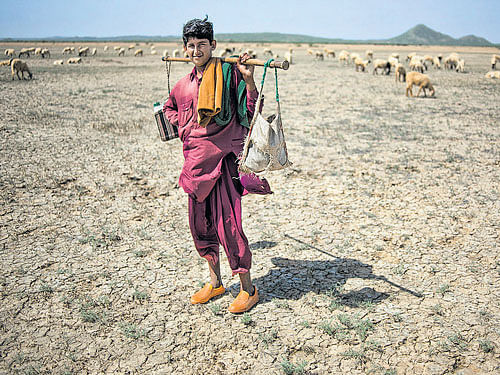
There is no place on earth like Banni, which is an amalgamation of an emergent peninsular land mass, volcanic hills and a salty-marshy desert. On top of all these, it is a grassland ecosystem. Located in Rann of Kutch in Kutch District, Gujarat, Banni is a 3,800 sq kms of prime grassland. In this vast spread, one can see varied flora and fauna, of which some are endangered.
Glimpses of Banni
Though Banni is essentially a drought prone area, it has one important natural wetland: the Chari-Dhand. This is the biggest water body in the area and a lifeline for humans and livestock. It is also home to one of the biggest congregation of cranes and flamingos in the country.
It is known for diverse flora and fauna as well. For flora, it is mostly dominated by low-growing plant species; many of which are halophytes (salt tolerant), and scatted tree cover and scrub. Its tree cover is primarily composed of Salvadora persica (mustard bush) and the invasive Prosopis juliflora. Dominant species include Cressa cretica and the grasses in the genera Sporobolus, Dichanthium and Aristida.
Banni is famous for its rich birdlife. It hosts many important bird species, both resident and transient. White-eared bulbul, Temminck’s stint, Marshall’s iora, Eurasian stone-curlew, Red-tailed shrike are some of the birds that one can see here. Endangered birds recorded in Banni include Dalmatian pelican, Oriental darter, Black-necked stork, Marbled duck, Indian skimmer, Cinereous vulture, Lesser florican, Houbara bustard and White-winged black tit. Animals like chinkara, golden jackal, Indian hare, Indian wolf, Asiatic wildcat and dessert fox are also seen.
Kiro Hill is one of the most prominent landmarks in Banni. It is a prehistoric volcano that has gone quiet over the millennia. The current-day Kutch is a world very different from the olden times. The colourful rock formations found around this region show a world when it was young and restless.
The Gujarat government is developing Chari-Dhand Wetland Conservation Reserve, along with the surrounding areas in and around Banni grasslands. The climate is arid with an average rainfall of only 315 mm per year between June and September. The number of monsoon days in a year usually does not exceed 5. Banni almost has no rivers or natural streams. However, about 100 rivers and rivulets flowing northwards from the Kutch mainland drain into the grasslands of Banni along its southern boundary. This area near the boundary gets flooded during the rainy season mainly by the water brought by these rivers.
Path less travelled
While this region is well known for its rich wildlife and geological connection, there is one story in Banni, that’s not well explored. It’s something that still has no reliable photo documentation or proper scientific explanation: the elusive Chir Batti. As a part of our Unseen Landscapes Expedition, we decided to explore the subject and investigate the claims behind this phenomenon. Was it an urban legend or a natural phenomenon that has never been properly documented? We wanted to find out. So, a goal was set by the team to explore Banni, see the Chir Batti, and document it. Chir Batti is a light occurring on dark nights and the word translates to ghost light in the local Kutchhi-Sindhi language.
Chir Batti is said to be caused by the oxidation of gases phosphine, diphosphane, and methane. These gases are produced here by the organic decay of the prehistoric vegetation trapped underneath the soil. These gases spontaneously ignite on contact with oxygen in air to create the ephemeral fires. This makes one believe that the occurrence of Chir Batti is quite possible. But hunting for Chir Batti is not easy. The modus operandi involved looking for any unexplained light sources during night and verifying its origin. We also had to deal with all the nocturnal critters and crawlers.
While we were exploring the grasslands, we encountered the Fakrirani (Salvani), a Muslim vegetarian community. They are camel herders and are extremely tough, physically and mentally. It is said that they can walk up to 70 km at once in search of camel, if they lose any. We also came across another group, Dhaberias, who are sheep herders. Dressed in a very stylish way in a dhoti, they looked busy to head towards their settlement to reach on time for the daily prayer. Talking to the local communities on their previous Chir Batti sightings helped confirm the unpredictability of the phenomenon.
There is no way to know when and where the flames may appear. We spent several nights traversing the plains between Kiro and Chari-Dhand hunting for these elusive flames. Everyone was focussed. While driving around the plains in darkness, there were multiple moments when the team was confronted with the sudden appearance of lights across the horizon. There were many false alarms and these usually had a rather easy explanation. There was this one time that the team did come across an unexplained light spec across the distant horizon and it vanished as quickly as it had appeared. Could this actually been an image of Chir Batti?
Chasing the unusual occurrence like Chir Batti is like playing with unpredictable luck. It offered us a never ending curiosity. Temperature started soaring day by day. Wetness of the land subsided. Our hope dimmed in the dust that rose. However, while that may have been the case, there was much to see in Banni.